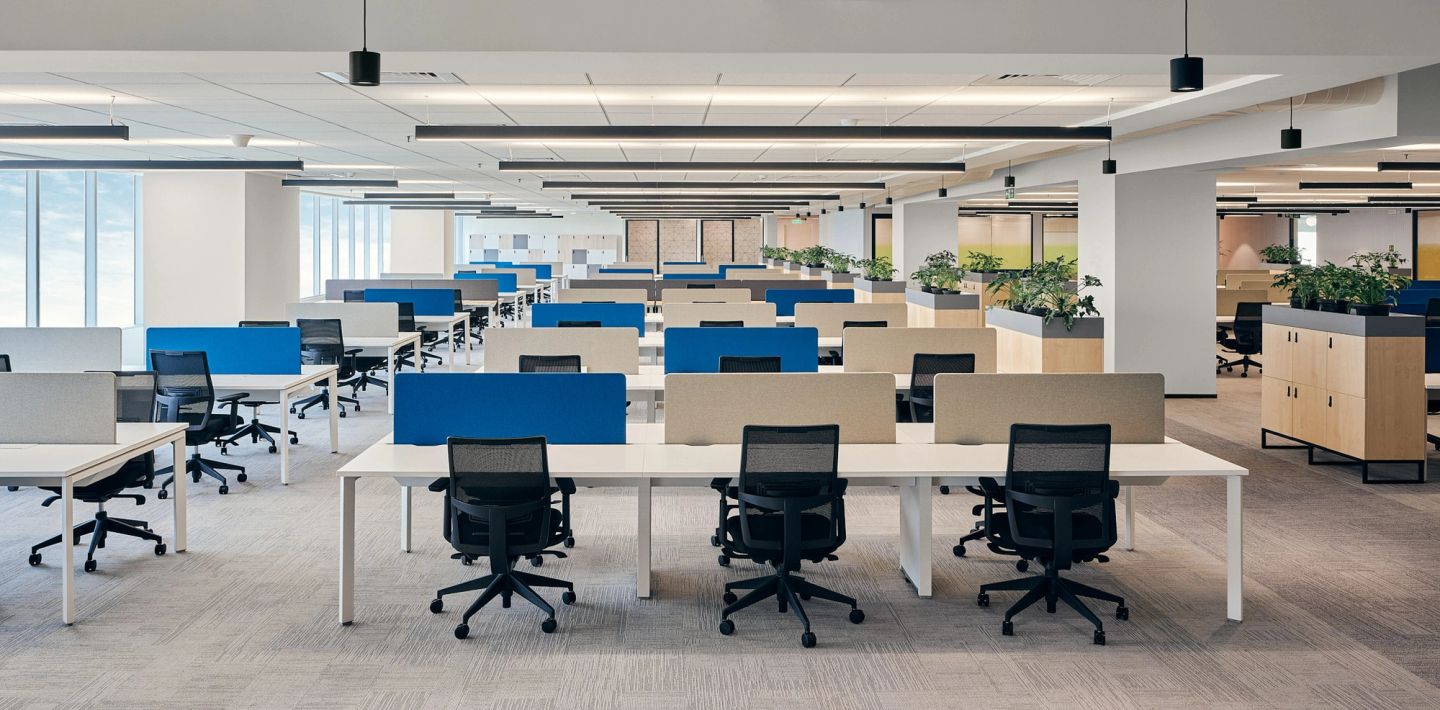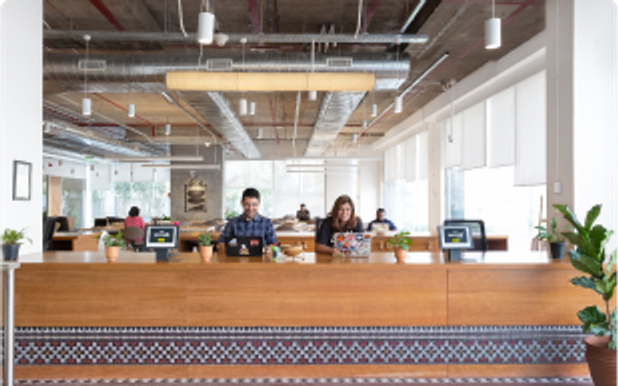WORKSPACE SOLUTIONS
Understanding the different types of office spaces

Explore the different types of office spaces available, from private offices to coworking spaces. Learn how to choose the best fit for your business with WeWork.
Understanding the different types of office spaces
Selecting the right office space plays a key role in ensuring productivity and growth in today's dynamic work environment. With the various options available, it is essential to understand the different types of office spaces to make an informed decision.
In this blog, we will explore the different types of office spaces, helping you choose the perfect office environment for your business.
Types of office spaces
Traditional office
A traditional office space is a conventional setup where a company leases or owns a dedicated building or floor. These offices typically feature private cabins, meeting rooms, and a reception area. Traditional offices offer privacy, security, and control over the workspace environment.
Advantages:
- Complete control over the office layout and design.
- Enhanced privacy and security.
- Long-term stability and brand establishment.
Disadvantages:
- High costs of leasing or purchasing property.
- Long-term lease commitments.
- Maintenance and utility management responsibilities.
Open office
An open office is a modern workspace concept that features a large, open area with minimal partitions. This layout encourages collaboration and communication among employees.
Advantages:
- Promotes teamwork and collaboration.
- Flexible and adaptable to changing needs.
- Cost-effective in terms of space utilisation.
Disadvantages:
- Noise and distractions can hinder productivity.
- Lack of privacy.
- Potential for decreased employee satisfaction.
Also Read: What is an open office
Virtual office
A virtual office provides businesses with a professional address and communication services without a physical workspace. Employees work remotely, and the company can use the virtual office address for correspondence and meetings.
Advantages:
- Cost-effective as there is no need for a physical office space.
- Flexibility for employees to work from anywhere.
- Professional business address and communication services.
Disadvantages:
- Lack of physical interaction and team bonding.
- Potential for reduced productivity.
- Limited access to office facilities and meeting rooms.
Here is a quick guide to setting up virtual offices in India.
Coworking space
A coworking space is a shared workspace where individuals from different companies work together in a communal setting. These spaces often provide amenities such as high-speed internet, meeting rooms, and cafes.
Advantages:
- Cost-effective and flexible membership plans.
- Networking opportunities with other professionals.
- Access to modern amenities and facilities.
Know more about the benefits of a coworking space.
Disadvantages:
- Potential for distractions and noise.
- Limited privacy.
- Dependence on the coworking space provider for facilities and maintenance.
Also Read: Coworking Vs Traditional Office
Shared office
A shared office is similar to a coworking space but is typically shared by two or more businesses. These spaces offer a combination of private offices and communal areas, allowing companies to share resources and reduce costs.
Advantages:
- Cost-sharing reduces overhead expenses.
- Networking and collaboration opportunities.
- Access to shared amenities.
Disadvantages:
- Potential for conflicts over shared resources.
- Limited control over the office environment.
- Privacy concerns.
Private office
A private office is a dedicated, enclosed workspace within a larger office building or coworking space. This type of office provides exclusivity and privacy for businesses that require confidential environments.
Advantages:
- Enhanced privacy and security.
- Control over the office environment.
- Professional and exclusive setting.
Disadvantages:
- Higher costs compared to shared spaces.
- Limited opportunities for networking and collaboration.
- Longer lease commitments.
Managed office
A managed office is a fully equipped office space provided and managed by a third-party operator. These offices come with utilities, maintenance, and administrative support included in the rental agreement.
Advantages:
- Ready to use with minimal setup time.
- Flexible lease terms.
- Access to professional services and amenities.
Disadvantages:
- Higher costs compared to traditional leases.
- Limited customisation options.
- Dependence on the service provider for maintenance and support.
Serviced office
Similar to managed offices, serviced offices offer fully furnished and equipped spaces with administrative support, IT infrastructure, and often reception services. They are typically located in prime business districts and offer flexible lease terms. The key difference from managed offices can be the level of service and the focus on a more premium experience.
Advantages
- Ready to use
- Flexible terms
- Professional image
- Comprehensive services
Disadvantages
- Higher cost
- Less customisation than traditional offices
Hot desks
This arrangement within a coworking space or larger office involves unassigned workstations that are available on a first-come, first-served basis. It is ideal for highly mobile workers or those who only need a workspace occasionally.
Advantages
- Highly flexible
- Cost-effective for occasional use
- Encourages interaction
Disadvantages
- Lack of a dedicated workspace
- Potential for inconsistency in the work environment
Hybrid office
This model combines elements of traditional office spaces with remote work. Companies might have a smaller central office for meetings and collaboration, while employees have the flexibility to work from home or other locations for focused tasks.
Advantages
- Increased flexibility for employees
- Potential cost savings on office space
- Improved work-life balance
Disadvantages
- Requires strong communication and management strategies
- Potential for isolation and decreased team cohesion if not managed well
Executive suites
These are usually found within larger office buildings and offer smaller, self-contained office units with shared amenities like reception areas and meeting rooms. They cater to small businesses or individual professionals who need a professional presence without the overhead of a full traditional office.
Advantages
- Professional image
- Cost-effective for small businesses
- Access to shared amenities
Disadvantages
- Limited space
- Less control over shared areas
Choosing the right office space for your business
Selecting the right office space depends on various factors such as your business size, budget, and operational needs. Here are some tips to help you make the right choice:
- Assess your needs: Make a note of the number of employees, the required facilities, and the preferred location.
- Budget considerations: Evaluate the costs associated with each type of office space and choose one that fits your budget.
- Flexibility: Consider the lease terms and the potential for future expansion.
- Employee preferences: Take into account your employees' work preferences and the impact on their productivity and satisfaction.
- Amenities and services: Identify the amenities and services that are essential for your business operations.
Summing up
Understanding the different types of office space is essential for selecting the perfect workspace for your business. Whether you opt for a traditional office, a coworking space, or a virtual office, each type has its unique advantages and challenges. So, carefully evaluate your needs and consider the various options to create an office environment that fosters productivity and growth.
FAQs
What is an office space?
An office space is a designated area where businesses conduct their operations. It can range from traditional offices to modern coworking spaces, providing a conducive work environment.
What type of office space is ideal for startups and small businesses?
Flexible office spaces or coworking spaces are excellent choices for new and small businesses. They are affordable, simple to modify as your company expands, and include common amenities like ergonomic chairs, meeting spaces, and fast internet.
What are the advantages and disadvantages of a traditional office space?
Traditional office spaces offer the advantage of complete control over the office layout and design, enhanced privacy and security, and long-term stability which helps in brand establishment. However, they come with some disadvantages like high costs of leasing or purchasing property, long-term lease commitments, and the responsibilities of maintenance and utility management.
What are the advantages and disadvantages of a coworking space?
Coworking spaces offer cost-effective and flexible membership plans and provide excellent networking opportunities with other professionals along with access to modern amenities and facilities. However, they come with potential disadvantages such as distractions and noise, limited privacy, and dependence on the coworking space provider for facilities and maintenance.
How do I choose the right type of office space for my business?
To choose the right type of office space, assess your business needs, budget, and operational requirements. Consider factors such as the number of employees, required amenities, lease terms, and the potential for future growth. Taking employee preferences and productivity into account is also crucial for making the right decision.
Related Blogs:

WORKSPACE SOLUTIONS
A workspace is not just about the work. It is also about providing employees a space that allows them the freedom to work where, when, and how they want. Flexibility...

WORKSPACE SOLUTIONS
Businesses should grow smart, not just big. Today, when every business looks forward to expanding its operations or network

